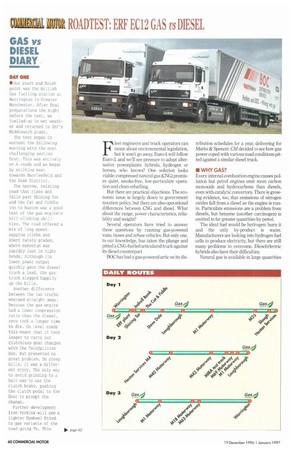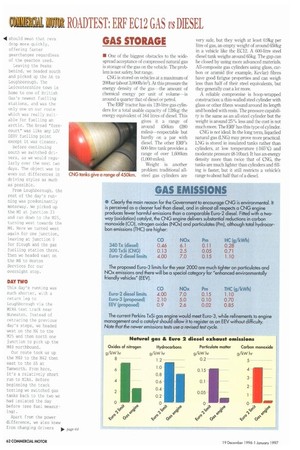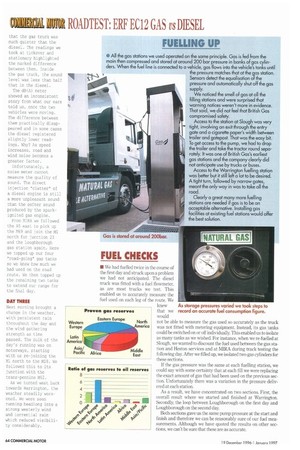GAS vs DIESEL DIARY
Page 62

Page 64

Page 66

If you've noticed an error in this article please click here to report it so we can fix it.
DAY ONE
IlOur start and finish point was the British Gas fuelling station at Warrington in Greater Manchester. After final preparations the night before the test, we fuelled up in wet weather and returned to ERF's Middlewich plant.
The test began in earnest the following morning with the most challenging section first. This was entirely on A-roads and we began by striking east towards Macclesfield and the Peak District.
The narrow, twisting road that rises and falls past Shining Tor and the Cat and Fiddle Inn to Buxton was a good test of the gas engine's hill-climbing abilities. The road offered a mix of long speedsapping climbs and short twisty grades, where momentum was rapidly lost in tight bends. Although its lower power output quickly gave the diesel truck a lead, the gas truck slogged happily up the hills.
Another difference between the two trucks emerged straight away. Because the gas engine had a lower compression ratio than the diesel, revs took a longer time to die. On level roads this meant that it took longer to carry out clutchless gear changes with the TwinSplitter box, but presented no great problem. On steep hills, it was a different story. The only way to avoid grinding to a halt was to use the clutch brake, pushing the clutch pedal to the floor to prompt the change.
Further development from Perkins will see a lighter flywheel fitted to gas variants of the
road-going Tx. This O. page 62
should mean that revs drop more quickly, offering faster gearchanges regardless of the gearbox used.
Leaving the Peaks behind, we headed south and picked up the A6 to Loughborough. The Leicestershire town is home to one of British Gas's newest fuelling stations, and was the only one on our route which was really suitable for fuelling an arctic. The broad 'forecourt" was like any Loy DERV fuelling point except it was cleaner.
Before continuing south we switched drivers, as we would regularly over the next two days. The object was to even out differences in driving styles as much as possible.
From Loughborough, the rest of the day's running was predominantly motorway. We picked up the 1.11 at junction 23 and ran down to the M25, turning west towards the M4. Here we turned west again for one junction, leaving at junction 5 for Slough and the gas fuelling station there. Then we headed east on the M4 to Heston Services for our overnight stop.
DAY TWO This day's running was much shorter, with a return leg to
Loughborough via the MIRA test track near Nuneaton. Instead of retracing the previous clay's steps, we headed west on the 144 to the M25 and then north one junction to pick up the M40 northbound.
Our route took us up the M40 to the M42 then east to the A5 at
Tamworth. From here, it's a relatively short run to MIRA. Before beginning the track testing we switched gas tanks back to the two we had isolated the day before (see fuel measuringl.
Apart from the power difference, we also knew from changing drivers that the gas was much quieter than the diesel. The readings we took a: tickover and stationary highlighted the marked difference between them. Inside the gas :ruck, the sound level was less than half that in the diesel.
The dB(A) meter
showed an inconsistent story from what our ears told us, once the two vehicles were moving. The difference between them practically disappeared and in some cases the diesel registered slightly lower readings. Why? As speed increases, road and wind noise becomes a greater factor.
Unfortunately, a noise meter cannot measure the quality of sound. The direct injection 'clatter of a diesel engine is still a more unpleasant sound than the softer sound produced by the sparkignited gas engine.
From MIRA we followed the A5 east to pick up the M69 and join the MI north for junction 23 and the Loughborough gas station again. Here we topped up our four "road-going" gas tanks so we knew how much we had used on the road route. We then topped up the remaining two tanks to extend our range for the 5nal day.
DAY THREE
Next me:•,g, brought a change in the weather, with persistent rain throughout the day and the wind gathering strength as time passed. The bulk of thr day's running was on motorways, starting with us re-joining the Ml north to the KB. We followed this to its junction with the trans-pennine M62.
As we turned west back towards Warrington, the weather steadily worsened. We were soon running headlong into a strong westerly wind and torrential rain which reduced visibility considerably.








































































































































